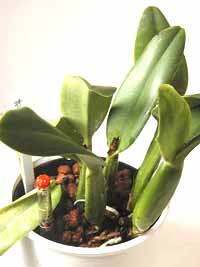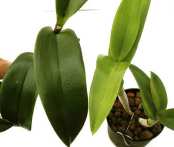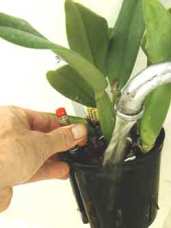

| Orchid Care -
Cattleya (KAT-lee-a) | |||||
If you're growing orchids in a greenhouse or outside in your back yard, Cattleya's can be among the easiest plants to grow. On the other hand, if your growing area is a windowsill in your house, Cattleya's might be a challenge. This is a wide, diverse group of plants that range in size from small windowsill plants to specimens over 4ft tall! If you're growing indoors, choose your Cattleyas carefully. They need high light. A big, unruly plant that demands all your window space can be a problem. In Nature
Cattleya grow as air plants (epiphytes) high in the
trees of the tropical forest. Their thick, fleshy roots anchor the
plant to the tree while collecting rain water from the occassional
shower. Their root system is exposed to the elements and
endure
long dry periods between rain showers. |  Cattleyas love our
Hydroponic System | ||||
Light Because Cattleya's grow high in the trees they require strong light with some direct sun. Their foliage should be rigid and medium to light green in color. If the leaves are dark green and floppy, the plant isn't getting enough light. If your plant refuses to bloom, it's probably not getting enough light! On the other hand, if the leaves are hard and yellowish the plant is probably getting too much sun. In your home, Cattleya's prefer the spot nearest an east or west window. Without additional lighting, north facing windows just won't do. In Northern climates, Cattleya's will thrive outside on the patio during the summer months. When outside, always remember to protect your plants from the hot mid-day sun. |  Cattleyas require lots of light. Leaf color should be light green as shown on the plant on the right. | ||||
Watering In Nature, the exposed roots of Cattleya dry out quickly after rain showers. That means their planting material must drain easily and dry out promptly. Their roots need lots of air or they will rot. The clay pebbles of our Hydroponic System are perfect for this! | |||||
| |||||
| To
establish an accurate watering schedule, make sure system is completely
dry before rewatering. This could be a week after the gauge reads
empty! Always error on the "dry side" with these plants. Don't be too
concerned about hitting the exact day - established plants are very
forgiving in our system. During the summer growing season, Cattleya will drink a lot more water than other times of the year. | |||||
| The Blooming Season Most Cattleyas will bloom once a year, some more often. Flowers last 1-3 weeks. There is no single season when Cattleya flower. After the first flower opens, move plant away from hot sun to prolong the blooms. These plants need direct sun and cool evening temperatures to develop flower buds. Winter evening temperatures of 55 degrees (or less) initiates the bloom cycle for most plants. If your plant has been growing well for several years without producing a bloom, it's almost always too little light. |  | ||||
| The Growing Season Cattleyas do best when neglected. They're very tolerant as long as they get enough sun and not too much water. The best growing area is a window that gets a couple of hours of direct sun. Cattleya's will thrive outside on the patio during the summer months. When outside, always remember to protect your plants from the hot mid-day sun. After Cattleyas finish blooming, they take a rest before the growing season starts. During this period, water sparingly by just running plain water through the pebbles (no nutrients). Don't allow standing water at the base. When you see new growth increase water to 1/4 - 1/2 on gauge and begin applying nutrients full strength. The growing season has begun! Don't try to force new growth - these plants have their own internal calendars. Your plant could be dormant for several months before the growing season starts. Any questions? Read first sentence of this section again. During the summer growing season Cattleya will drink a lot more water (2-3 times as much) than other times of the year. |  After the bloom cycle, be stingy with the water. Just run water through the pebbles - no standing water at the base until new growth starts. | ||||
Temperatures Cattleyas grow in a wide range of temperatures. To perform best, they need temperatures that range from 55 degrees at night and up to 90 degrees during the day. Good air circulation and adequate humidity during the winter months are also recommended.
|
| ||||



